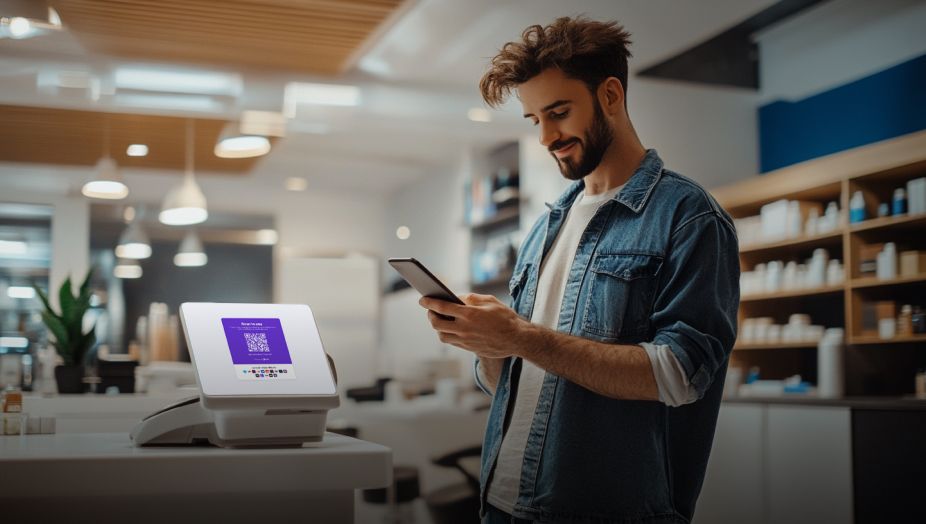
Digital payments continue to dominate, with total cash use expected to decline to just 6% of total payments made in the UK by 2033.
QR codes have emerged as a powerful tool for in-person transactions that bypass expensive card networks and facilitate faster payments. For UK merchants and businesses, adopting QR code stands in-store can offer customers a quick and convenient check-out process to enhance customer experience, while also reducing merchant transaction costs.
This guide will walk you through everything you need to know about using QR code stands for payment initiation and how Noda’s open banking QR codes are one of the most competitive solutions on the market.
What Are QR Code Stands?
QR code stands are physical displays that feature a QR code, allowing customers to make payments by simply scanning the code with their smartphones. These stands can be placed at checkout counters, tables, or any convenient location within a store.
They serve as a bridge between the physical and digital worlds, enabling seamless and contactless transactions.
What Are QR Code Payments?
QR code payments involve using a QR code to initiate a transaction. When a customer scans the QR code with their smartphone, they are directed to a secure payment page where they can complete the transaction.
The exact check-out method and efficiency of the process depends on the Payment Service Provider (PSP) supporting the QR code payments. Typically, payments are completed by:
- Credit/debit cards: Customers manually enter card details on the payment page, like any online check-out form.
- Digital wallets: Card payments are authorised through mobile wallets like ApplePay or Google Pay, which store card information for quicker card payments.
- Payment apps: Common payment apps include PayPal or Revolut, and can facilitate mobile-based transactions.
- Open banking: Uses account-to-account transfers, so merchants receive funds into their bank instantly.
Benefits of using QR code payments and QR code stands
QR code payments are quick, secure, and eliminate the need for physical cash or card swipes, offering both merchants and customers several advantages over traditional payment methods:
- Contactless Transactions: QR code payments eliminate the need for physical contact, enhancing safety for both customers and staff.
- Speed and Convenience: Transactions are completed quickly and efficiently, reducing wait times and improving overall customer experience, while merchants can benefit from instant bank transfers.
- Lower costs: Many QR code payments work without the need for hardware, and when you choose an open banking PSP, you can skip expensive card networks altogether.
- Versatility: QR code stands can be used in various settings, from retail stores to restaurants, making them a versatile payment solution.
Stands for QR codes allow payment processes to just about take care of themselves. By positioning on product shelves, at sales counters or elsewhere around your store, customers can quickly and easily check-out, with multiple customers paying simultaneously. The user-intuitive interfaces free-up your time for customer service and cuts your queue-times.
You can also display your QR code holders and accept payments on-the road – whether you’re showcasing your products and services at a bustling market, a festival, pop-up events, or tradeshows.
How do you setup QR code payments for your shop?
In order to accept in-person QR code payments, you first need to select the right Payment Service Provider for your business. You can read our full guide on what to look for in a PSP, but a few key considerations are:
- Security and compliance
- Ease of integration of QR codes
- QR code payment methods
- Fees and costs involved
At Noda, we’ve made it ridiculously easy to get started with QR code payments and set up your QR code stands for payments. Here’s how:
- Sign up with Noda: Our onboarding process is quick and simple, with your Noda representative on hand throughout. Whether you want solely QR code payments, or need a full suite of payment solutions, we’ll have you onboarded on no time.
- Generate a QR Code: Navigate to ‘QR codes’ in your Noda dashboard, then generate your unique codes. Use dynamic codes for flexible and changeable payments or fix the amount with a static code.
- Display the QR Code: Use a QR code sign holder or stand for maximum visibility, and place at your sales counter or elsewhere around your shop. You can also display via your mobile or tablet screens.
- Customers Scan the QR Codes: Using their smartphone cameras, customer scan the codes and authorise the transaction directly in their banking app. The amount can be entered by either merchant or customer. Funds are then transferred directly from the customer's bank account to yours, giving you a real-time payment notification to your dashboard.
Why Noda’s QR code stands for payment are better for business
Noda offers a robust and competitive QR code payment solution that stands out in the market. Here are just a few ways Noda can benefit your business:
- No set up cost: No card terminals, no hardware maintenance and no technical skill required
- Ultra-low fees: Just £0.20 per transaction, with no monthly fees – saving you up to 80% compared to traditional card networks.
- Real-Time Transfers: Enjoy instant bank transfers, directly from the customer’s account to yours and say cheerio to slow card settlement times.
- Enhanced Security: Advanced encryption, strong customer authentication (SCA), fully PSD2 compliant and FCA registered (UK) - protecting your sensitive financial information and reducing fraud.
- 24/7 Customer Support: With Noda, you have a dedicated manager who knows your business and understands your needs., whenever you need.
- Versatile: Use with QR code holders around your store, print out to take with you on-the-go, share on your tablet or mobile, or send digitally via email/SMS/chat.
- Easy-to-use: Generate QR codes within seconds, easily manage your payment dashboard and provide customers with an ultra-easy user interface.
Add QR code stands for payment to your store today
QR code payments enable you to leverage modern fintech and bring better payment solutions to your business and your customers.
Forget clunky card terminals, slow settlements and expensive transaction-based fees associated with the traditional card networks. Instead, enjoy instant bank transfers, low fees and a convenient payment solution that you can take with you wherever your business goes. And your customers enjoy absolute convenience, with no wallet needed; simply scan, pay, go.
Noda’s QR codes, powered by cutting-edge open banking tech, deliver digital payments that meet modern consumer demands, while optimising your business operations and future-proofing your payment processes.
Speak to the Noda team today to get started with QR codes for quick, easy payments.
FAQs
How secure are QR code payments?
QR code payments are highly secure, especially when using Noda's solution. The transactions are encrypted, and strong customer authentication (SCA) is used to verify the identity of the payer, reducing the risk of fraud.
Can QR codes be used for recurring payments?
Yes, QR codes can be used for recurring payments if the Payment Service Provider supports this type of transaction. Merchants can generate a unique QR code for each billing cycle, allowing customers to make payments easily and consistently. Great for things like gym memberships or coffee clubs.
What are QR code stands for?
QR code stands explained simply are a way for shops, cafes, restaurants, car garages and any other UK businesses that operates mainly offline, to easily display their QR codes for customers. By placing around the store or at sales counters, customers can quickly and easily scan the codes to initiate the associated payment process.
Latest from Noda

GoCardless Review 2025: What Merchants Need to Know

Alternative Payment Methods UK: Your Complete Guide to Modern Payment Solutions

Plaid Review for Merchants: Data, Payments, Pros & Cons, and More


